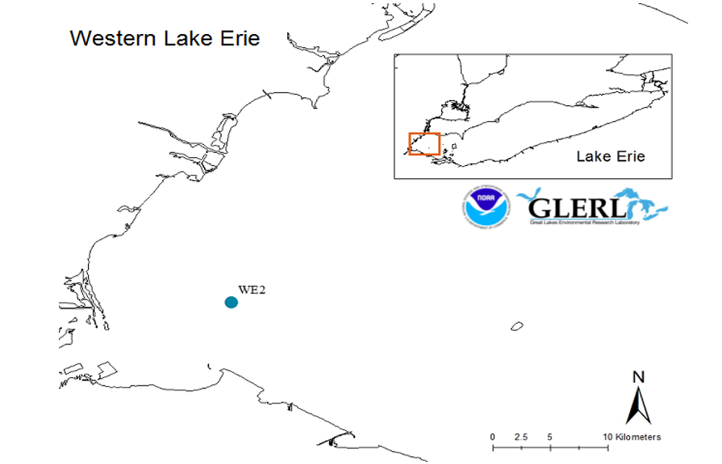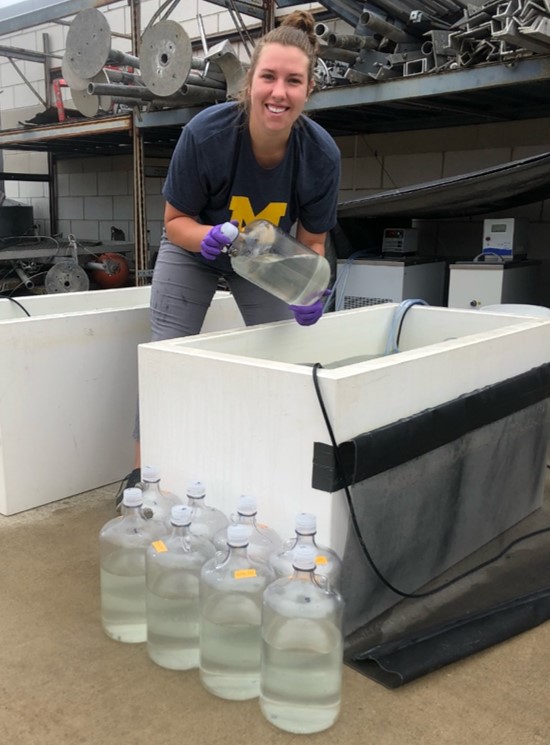Summer 2018 eNewsletter
FEATURED RESEARCH
Phosphorus Reduction in Lake Erie: The Solution to Harmful Algal Blooms?
Mikayla Baer (Dr. Thomas Johengen), University of Michigan

Figure 1: Map of the western basin of Lake Erie, identifying sampling location WE-2.
The toxin-producing harmful algal blooms (HABs) that plague parts of Lake Erie have become more widespread and intense in Lake Erie over the recent years, prompting scientists and managers to look for solutions to the problem.
Regulations set by the Great Lakes Water Quality Agreement (Annex 4) are outlined to reduce the total phosphorus load into Lake Erie by 40% by the year 2025. This is expected to reduce algal biomass given the major role phosphorus is understood to have in promoting algal blooms. However, recent studies suggest that nitrogen could also play a vital role in the growth of toxin producing harmful algae, and that the availability and type of nitrogen present in the system is also linked to the overall HAB toxicity. This leaves scientists wondering if reducing phosphorus alone will achieve the desired reductions in HABs and their related toxins.
Mikayla Baer is an M.S. student at the University of Michigan and a 2017-2019 CIGLR Graduate Student Research Assistant, advised by Dr. Thomas Johengen and co-mentored by Drs. Casey Godwin (CIGLR), Timothy Davis (Bowling Green State University) and Gregory Dick (University of Michigan). The goal of her assistantship research is to provide a better understanding of how phosphorus concentration influences the production of algal biomass and toxins in the Great Lakes, with focus on the western basin of Lake Erie.
Mikayla’s research takes place in the western basin of Lake Erie (Figure 1), which receives nutrient-laden water from a watershed dominated by agriculture (60-80%) and several large cities (e.g., Detroit, Toledo, Monroe). Excess nutrients, along with the warm and shallow waters of Lake Erie, make this area extremely susceptible to the formation of harmful algal blooms.

Figure 2: Mikayla tests the impact of phosphorus reduction on the algal blooms in Lake Erie by conducting a series of dilution experiments.
In Mikayla’s on-going experiments, she uses an established Lake Erie monitoring station (WE-2) to retrieve samples for water quality measurements and additional laboratory experiments (Figure 1). This station is approximately six meters (20 feet) deep and presents a good representative sample of the western basin. Mikayla’s laboratory tests consist of a series of dilution experiments, in which she simulates a 40% reduction in phosphorus and measures algal biomass, toxicity, and nutrient dynamics (Figure 2).
By creating conditions similar to those required by the Great Lakes Water Quality Agreement, her research will shed light on how HABs may be affected by meeting the prescribed phosphorus regulations. She also hopes to provide more insight on nitrogen’s role in toxin production when phosphorus is reduced, and management strategies aimed at mitigating cyanobacterial blooms.
Mikayla Baer is 2017-2019 CIGLR Graduate Student Research Assistant, mentored by CIGLR scientists Drs. Thomas Johengen and Casey Godwin. She is currently a Masters student at the University of Michigan School for Environment and Sustainability (UM SEAS). This assistantship has provided Mikayla with opportunities to collaborate with co-mentors outside of UM SEAS, specifically her co-mentors Drs. Tim Davis (Bowling Green State University) and Gregory Dick (UM Earth and Environmental Science).
Related Articles and Resources
Chaffin, J.D., T.W. Davis, D.J. Smith, M.M. Baer and G.J. Dick. 2018. Interactions between nitrogen form, loading rate, and light intensity on Microcystis and Planktothrix growth and microcystin production. Harmful Algae. 73:84-97. (DOI:10.1016/j.hal.2018.02.001).
